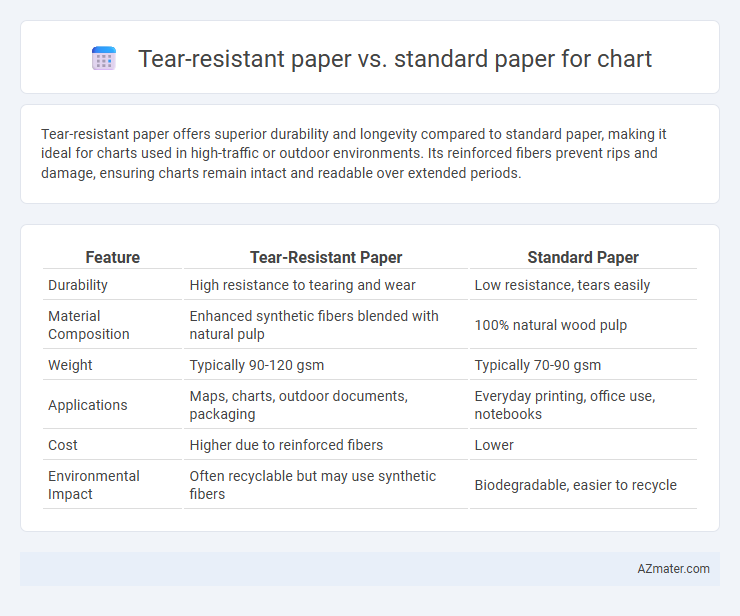Tear-resistant paper offers superior durability and longevity compared to standard paper, making it ideal for charts used in high-traffic or outdoor environments. Its reinforced fibers prevent rips and damage, ensuring charts remain intact and readable over extended periods.
Table of Comparison
| Feature | Tear-Resistant Paper | Standard Paper |
|---|---|---|
| Durability | High resistance to tearing and wear | Low resistance, tears easily |
| Material Composition | Enhanced synthetic fibers blended with natural pulp | 100% natural wood pulp |
| Weight | Typically 90-120 gsm | Typically 70-90 gsm |
| Applications | Maps, charts, outdoor documents, packaging | Everyday printing, office use, notebooks |
| Cost | Higher due to reinforced fibers | Lower |
| Environmental Impact | Often recyclable but may use synthetic fibers | Biodegradable, easier to recycle |
Introduction to Tear-Resistant and Standard Paper
Tear-resistant paper is engineered with reinforced fibers that enhance durability and prevent ripping, making it ideal for charts exposed to frequent handling or outdoor conditions. Standard paper lacks this reinforcement, resulting in higher susceptibility to tears and damage during regular use. Comparing the two, tear-resistant paper ensures longer-lasting charts with improved resilience, while standard paper offers a more cost-effective yet less durable option.
Key Material Differences
Tear-resistant paper is engineered with reinforced fibers and a synthetic coating that significantly enhances durability and resistance to tearing compared to standard paper. Standard paper commonly uses cellulose fibers without additional treatments, resulting in lower strength and susceptibility to damage under stress. The key material differences lie in the fiber composition and surface treatment, where tear-resistant paper's specialized additives improve tensile strength and endurance critical for charts exposed to frequent handling.
Durability and Longevity Comparison
Tear-resistant paper offers significantly higher durability than standard paper, with fibers engineered to withstand repeated handling and resist tearing under stress. Its longevity is enhanced by superior resistance to wear, moisture, and environmental factors, ensuring charts remain intact and legible over extended periods. Standard paper, in contrast, degrades faster, showing brittleness and susceptibility to tears, making it less suitable for long-term chart usage.
Tear Resistance: Real-World Performance
Tear-resistant paper demonstrates significantly higher durability under stress compared to standard paper, resisting rips and tears even in high-use chart applications. Its reinforced fibers and special coatings enhance longevity in environments where frequent handling or exposure to moisture occurs. This performance advantage reduces replacement frequency, ensuring charts remain intact and legible over extended periods.
Waterproof and Environmental Resistance
Tear-resistant paper offers superior waterproof qualities compared to standard paper, ensuring charts remain intact and legible even when exposed to moisture or spills. Its enhanced environmental resistance protects against UV rays, chemicals, and temperature fluctuations, extending the lifespan of charts in outdoor or industrial settings. Standard paper lacks these protective features, making it more prone to damage and reduced durability in challenging environments.
Print Quality on Charts
Tear-resistant paper offers superior durability without compromising print quality on charts, ensuring sharp, vibrant colors and clear text that withstand handling and environmental stress. Standard paper often absorbs ink differently, potentially causing smudging or fading, which diminishes chart legibility over time. Investing in tear-resistant paper enhances the longevity and visual precision of charts, critical for presentations and data analysis.
Cost Analysis: Tear-Resistant vs Standard Paper
Tear-resistant paper typically costs 30-50% more than standard paper due to its enhanced durability and material composition. While the initial expense is higher, tear-resistant paper reduces replacement and maintenance costs in high-use environments, offering long-term savings. Standard paper has lower upfront costs but may incur frequent replacements, increasing overall expenditure for charts used in demanding conditions.
Ease of Handling and Folding
Tear-resistant paper offers superior durability for charts, enabling repeated handling and folding without damage, unlike standard paper which tends to weaken and rip along folds. Its reinforced fibers maintain shape and integrity during frequent use, making it ideal for fieldwork and presentations. The ease of folding tear-resistant paper ensures neat creases without compromising strength, enhancing longevity and usability.
Sustainability and Eco-Friendliness
Tear-resistant paper outperforms standard paper in sustainability by reducing waste through its enhanced durability, leading to fewer replacements and less paper consumption. Manufactured with eco-friendly processes and often incorporating recycled fibers, tear-resistant paper supports reduced environmental impact compared to conventional paper options. Its longer lifespan and recyclability contribute to efficient resource use and lower carbon footprint in chart production.
Best Use Cases for Each Paper Type
Tear-resistant paper is ideal for charts used in high-traffic or outdoor environments where durability and resistance to ripping are essential, such as construction sites or fieldwork. Standard paper suits indoor use, providing cost-effective options for presentations, office charts, and short-term displays. Choosing tear-resistant paper ensures longevity in demanding settings, while standard paper offers ease and economy for everyday charting needs.

Infographic: Tear-resistant paper vs Standard paper for Chart
 azmater.com
azmater.com